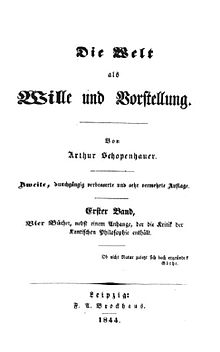The World as Will and Idea

The title page of the expanded 1844 edition
|
|
| Author | Arthur Schopenhauer |
|---|---|
| Original title | Die Welt als Wille und Vorstellung |
| Translator | Richard Burdon Haldane |
| Country | Germany |
| Language | German |
| Subject | Metaphysics |
| Published |
|
The World as Will and Representation (WWR; German: Die Welt als Wille und Vorstellung, WWV) is the central work of the German philosopher Arthur Schopenhauer. The first edition was published in 1818/19, the second expanded edition in 1844, and the third expanded edition in 1859. In 1948, an abridged version was edited by Thomas Mann.
In the English language, this work is known under three different titles. Although English publications about Schopenhauer played a role in the recognition of his fame as a philosopher in later life (1851 until his death in 1860) and a three volume translation by R. B. Haldane and J. Kemp, titled The World as Will and Idea, appeared already in 1883–1886, the first English translation of the expanded edition of this work under this title The World as Will and Representation appeared by E. F. J. Payne (who also translated several other works of Schopenhauer) as late as in 1958 (paperback editions in 1966 and 1969). A later English translation by Richard E. Aquila in collaboration with David Carus is titled The World as Will and Presentation (2008).
Present day translator Richard Aquila argues that the reader will not grasp the details of the philosophy of Schopenhauer properly without this new title: "The World as Will and Presentation." According to him, "Idea," "Representation," and "Presentation" are all acceptable renderings of the word Vorstellung, but it is the notion of a performance or a theatrical presentation that is key in his interpretation. The world that we perceive is a "presentation" of objects in the theatre of our own mind; the observers, the "subject," each craft the show with their own stage managers, stagehands, sets, lighting, code of dress, pay scale, etc. The other aspect of the world, the Will, or "thing in itself," which is not perceivable as a presentation, exists outside time, space, and causality. Aquila claims to make these distinctions as linguistically precise as possible.
The main body of the work states at the beginning that it assumes prior knowledge of Immanuel Kant's theories, and Schopenhauer is regarded by some as remaining more faithful to Kant's metaphysical system of transcendental idealism than any of the other later German Idealists. However, the book contains an appendix entitled critique of the Kantian philosophy, in which Schopenhauer rejects most of Kant's ethics and significant parts of his epistemology and aesthetics. Schopenhauer demands that the introduction be read before the book itself, although it is not fully contained in this book but appeared earlier under the title On the Fourfold Root of the Principle of Sufficient Reason. He also states in his introduction that the reader will be at his best prepared to understand his theories if he has lingered in the school of Plato or he is already familiar with Indian philosophy.
...
Wikipedia
